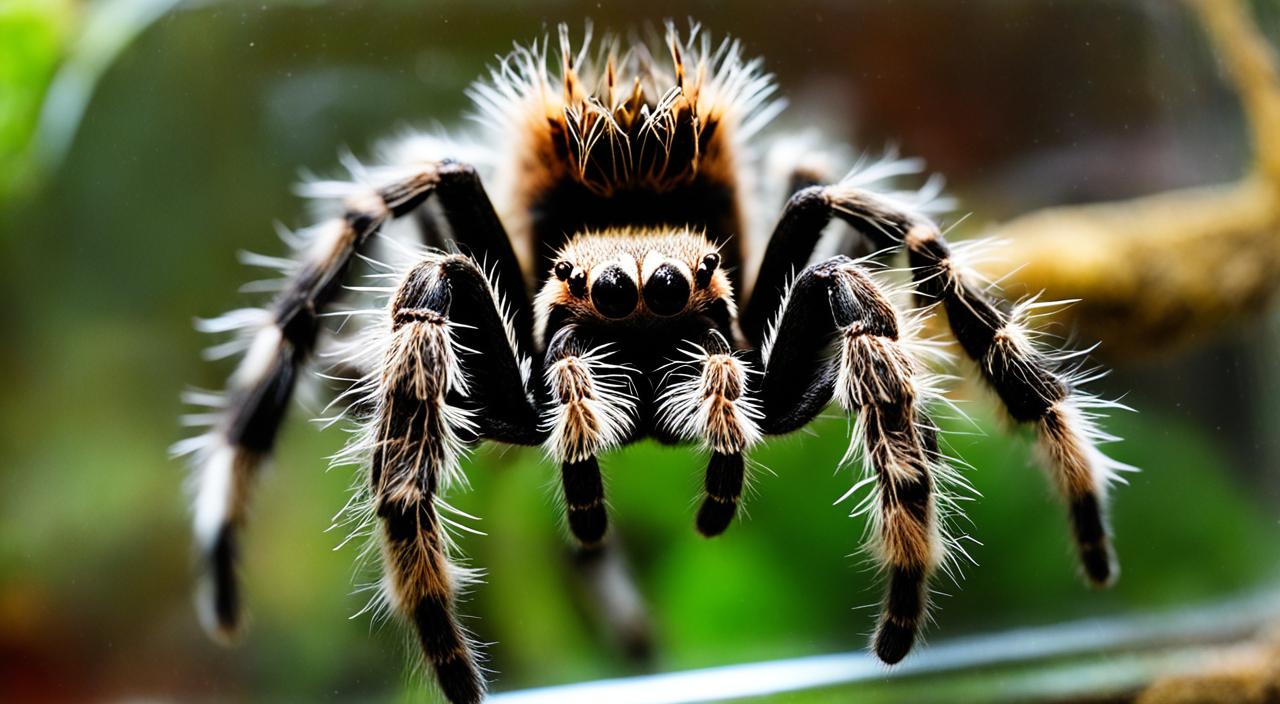Imagine a spider with a leg span up to 5.5 inches wide – that’s the Chilean rose tarantula. They are loved by spider fans for their beauty. Known as the rose hair tarantula or Grammostola rosea, they stand out with their red and orange colors.
These spiders look scary but are actually calm and friendly. They’re a great choice for beginners. With the right care, they can live up to 20 years in captivity.
Introduction to the Chilean Rose Tarantula
Common Names and Scientific Classification
The Chilean rose tarantula is also known as the rose hair or Chilean fire tarantula. Its scientific name is Grammostola rosea. This tarantula comes from the high desert and scrub of northern Chile, Bolivia, and Argentina.
Physical Appearance and Size
Chilean rose tarantulas have bodies that can be black or brown, with bright red and orange hairs. Adults have a leg span of 4.5 to 5.5 inches, with females being bigger than males. Their bodies are about 3 inches long.
The Grammostola porteri and Grammostola rosea species are the most common tarantulas in the U.S. hobby. They are often caught in the wild and brought to the U.S. in big numbers. This makes them a favorite among tarantula fans.
“The Chilean Rose Tarantula is still wild-collected and imported into the US pet trade in large numbers.”
Even though they are popular, it’s key to remember that not all Chilean rose tarantulas are easy to keep. Some might have problems with feeding, falling, or health.
Chilean Rose Tarantula
The Chilean rose tarantula, also known as the rose hair tarantula or Grammostola rosea, is a favorite among spider lovers. They are known for being calm and easy to care for, making them great for beginners. These tarantulas don’t need a lot of space or attention but do have ways to defend themselves.
These spiders are about 4.5 to 5.5 inches big and weigh 2 to 3 ounces. In the wild, males can live up to 5 years and females up to 20 years. In captivity, they can live just as long, with males up to 5 years and females up to 20 years.
| Characteristic | Details |
|---|---|
| Size | 4.5 to 5.5 inches |
| Weight | 2 to 3 ounces |
| Lifespan (Wild) | Male: up to 5 years, Female: up to 20 years |
| Lifespan (Captivity) | Male: up to 5 years, Female: up to 20 years |
| Mating Gestation Period | 6 to 7 weeks |
| Habitat | Chile, including Mediterranean climates and coastal rainforests |
| Diet | Insects, invertebrates, and occasional small vertebrates |
| Egg-Laying Capacity | 100 to over 500 eggs annually |
The Chilean rose tarantula, also known as the rose hair tarantula or Grammostola rosea, is a popular pet spider. They are found in northern Chile, Bolivia, and Argentina, at altitudes from 0 to 1,500 meters. Despite being popular pets, they face threats from habitat loss due to human activities like industrialization and urbanization.
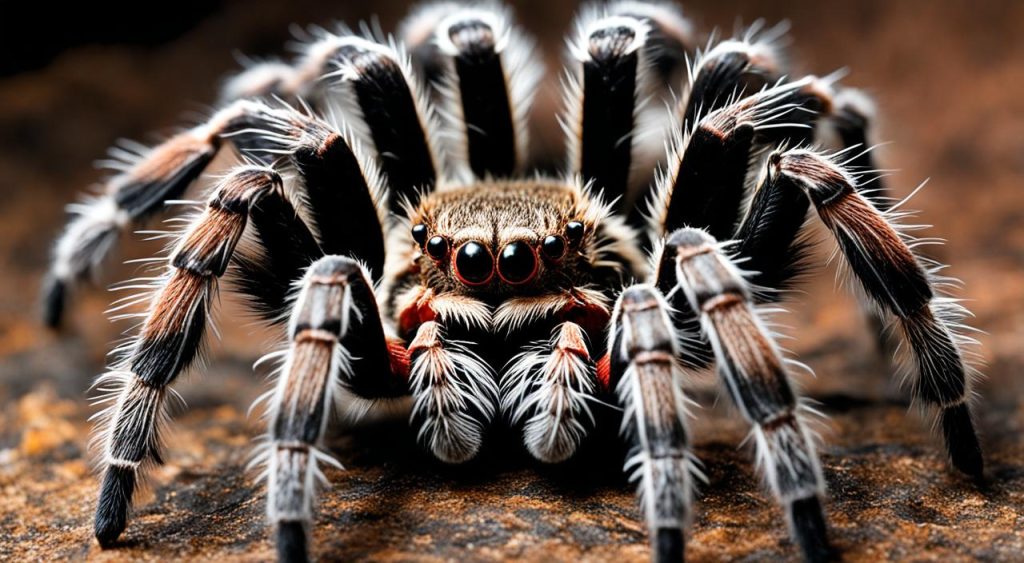
Temperament and Behavior
The Chilean rose tarantula, also known as the rose hair tarantula, is known for being calm and gentle. They don’t usually act aggressively or show off when they feel threatened. This makes them a favorite among tarantula lovers, even for beginners.
Docile Nature and Handling
Many Chilean rose tarantulas can be handled gently, but they’re not truly “tame” pets. They can learn to recognize their owners and might even get used to being handled. But, it’s key to be calm and not startle them, as they can quickly become defensive.
Defense Mechanisms: Venom and Urticating Hairs
Even though they’re usually calm, Chilean rose tarantulas have venom and urticating hairs for defense. Their venom isn’t dangerous to humans but can feel like a bee sting. They can also flick out urticating hairs that can irritate skin and eyes. So, it’s smart to wear gloves and eye protection when handling them.
“The Chilean rose tarantula is a fascinating and unique pet spider that captivates enthusiasts with its generally calm demeanor and intriguing defensive mechanisms.”
Caring for a Chilean Rose Tarantula
Housing Requirements and Environment
Creating a good home is key for a Chilean rose tarantula’s health. They need a 5- to 10-gallon tank or terrarium with lots of room to move and dig. The tank should have a secure lid and good airflow, and include a spot for hiding, like a hollow log or piece of driftwood. Use 2-3 inches of substrate like peat moss, soil, or coconut husk. These tarantulas do well in a humid environment, with a humidity level of about 65%.
Feeding and Hydration
Chilean rose tarantulas eat live insects like crickets in the wild. As pets, feed them a variety of nutritious insects. Feed them every 4-7 days as baby spiders, every 7-10 days as young ones, and every 2-3 weeks as adults. Give them 1-5 insects per meal, making sure they’re easy for the tarantula to catch. Also, keep a shallow water dish for them and change the water every day.
| Substrate Options | Pros | Cons |
|---|---|---|
| Potting Soil | Readily available Provides a natural look Helps maintain moderate humidity | Some tarantulas may be reluctant to burrow Requires frequent monitoring and replacement |
| Horticultural Vermiculite | Promotes natural burrowing behavior Retains moisture well | Some tarantulas may spend more time on the surface Can be more expensive than potting soil |
Choosing any substrate, make sure it’s the right depth and keep the moisture right. This helps make sure the Chilean rose tarantula‘s home is comfy and suits its natural ways.
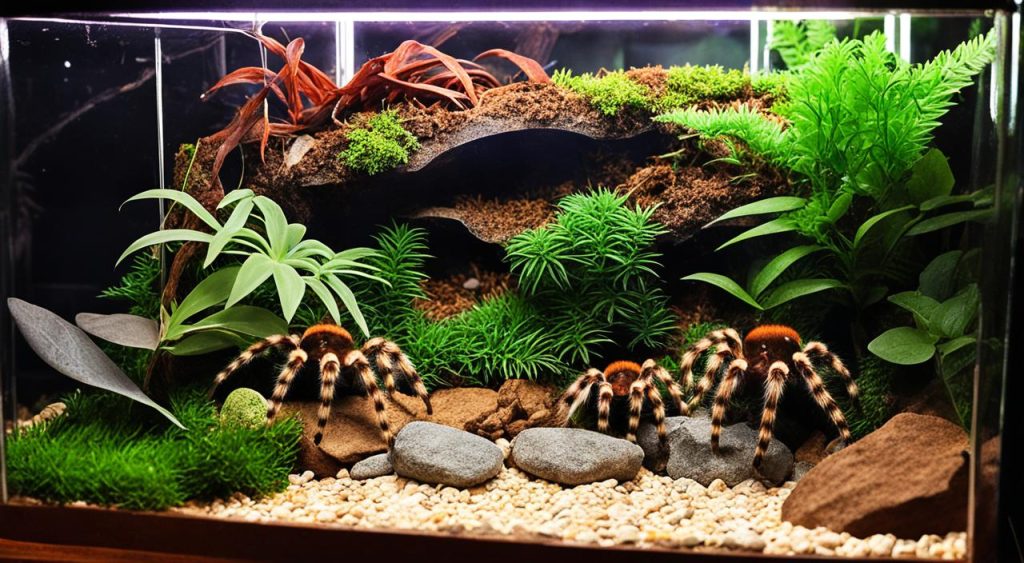
Molting Process and Health Concerns
The Chilean rose tarantula, also known as the Grammostola rosea or rose hair tarantula, is a fascinating and hardy spider. These spiders shed their skin during a molting process, getting a new, bigger one. It’s important not to feed or touch them during this time.
If molting seems off or lasts too long, see a vet right away. Chilean rose tarantulas are tough but can have health issues with molting and their exoskeletons.
Chilean rose hair tarantulas can live up to 20 years for females and 2 to 5 years for males in captivity. After they grow up, males stop molting a lot, while females keep molting their whole lives.
| Statistic | Value |
|---|---|
| Age of the tarantula | 8 years old |
| Gender | Male |
| Incidents of deformities during molting process | 3, including 2 minor and 1 major |
| Major deformity location | Left front leg next to pedipalp |
| Right fang color change | Bright red to dark red after being damaged |
| Biting difficulties | Uncoordinated right fang |
An 8-year-old male Chilean rose tarantula had several molting issues, including a big one on its left front leg. The right fang turned red to dark red, making it hard to bite prey.
These issues made the tarantula more defensive and aggressive. It hit things with its legs and pedipalps a lot. Feeding it became hard because of the biting problems.
As pet owners, watch the molting process closely. Get vet help if you see any problems or if molting lasts too long. With the right care, Chilean rose tarantulas can live long, healthy lives.
Exercise and Grooming Needs
Caring for a Chilean rose tarantula is easy. These spiders don’t need much exercise or grooming. Just give them a big enough enclosure to move around in.
The Grammostola rosea, or rose hair tarantula, is a calm and easy pet. They clean themselves by molting. Owners don’t need to help with grooming. Keeping the enclosure at the right temperature and humidity is enough to keep them healthy.
For fun and stimulation, add different hiding places, climbing things, and types of substrate to their home. But, these spiders are not very active. They don’t need a lot of handling to be happy and healthy.
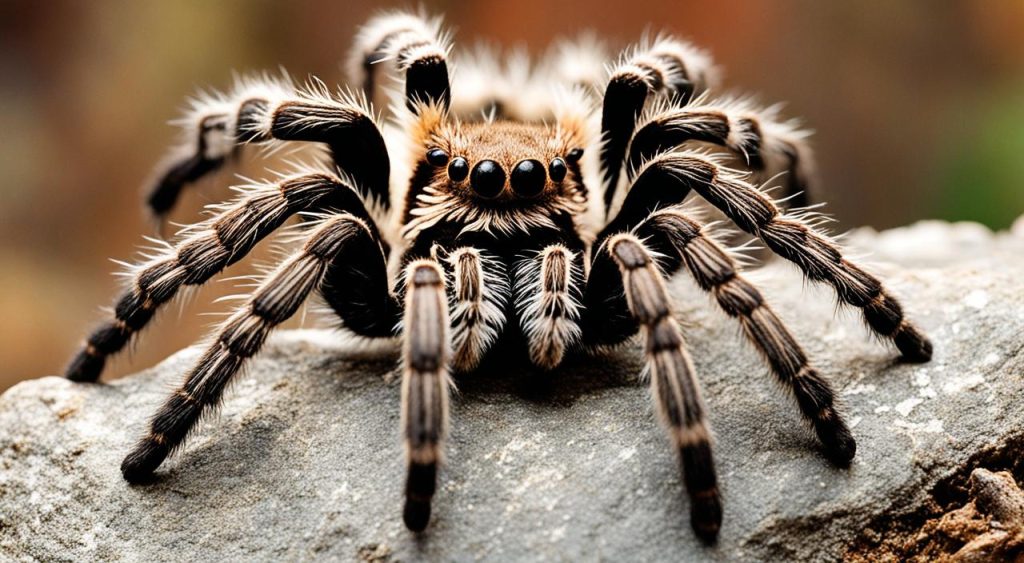
In short, the Chilean rose tarantula is easy to care for in terms of exercise and grooming. Make sure their environment is right and give them a good home. This way, you can enjoy these interesting spiders without much work or special care.
Cost of Owning a Chilean Rose Tarantula
Getting a Chilean rose tarantula, or Grammostola rosea, as a pet is rewarding. But, knowing the costs is key. Female tarantulas start at about $60 from trusted breeders. Males can be as low as $20, but they don’t live as long.
After buying your tarantula, there are ongoing costs. Feeding them live prey like crickets costs $5-$10 a month. You’ll also spend $10-$20 on substrate changes and new tank items. This makes up the cost of chilean rose tarantula and grammostola rosea pet expenses.
Don’t forget about vet bills and emergencies. Even though Chilean rose tarantulas are tough, they can get sick. Having a budget for vet care is smart. This includes costs for possible health issues over the spider’s life, which can be 4-5 years for males and up to 20 years for females.
Knowing the cost of owning a Chilean rose tarantula helps you decide. It makes sure you can give your new pet the right care and home.
Pros and Cons of Keeping Chilean Rose Tarantulas as Pets
The Chilean rose tarantula, also known as the rose hair tarantula (Grammostola rosea), is a favorite among those who love spiders. They are known for being calm and easy to care for. But, it’s important to think about the good and bad points before getting one as a pet.
Advantages of Chilean Rose Tarantulas as Pets
- Docile Temperament: Chilean rose tarantulas are calm and gentle. This makes them great for beginners.
- Easy Care: They need simple housing, food, and care. This is less work than other pet spiders.
- Affordable Ownership: Starting and keeping a Chilean rose tarantula is not expensive. This makes them a good choice for many people.
- Therapeutic Benefits: Being around these spiders can help people overcome a fear of spiders. Many owners say it helped them.
Disadvantages of Chilean Rose Tarantulas as Pets
- Defensive Behaviors: Even though they are calm, they can defend themselves. They might flick hairs or bite, so be careful.
- Limited Interaction: Tarantulas, like the Chilean rose, don’t interact much. They are not as engaging as some other pets.
- Lifespan Commitment: Female Chilean rose tarantulas can live up to 20 years. This means a big commitment from their owners.
Thinking about getting a Chilean rose tarantula as a pet? Make sure you know the good and bad sides. With the right care and respect, they can be interesting and easy pets.
| Advantages | Disadvantages |
|---|---|
| Docile Temperament | Defensive Behaviors |
| Easy Care | Limited Interaction |
| Affordable Ownership | Lifespan Commitment |
| Therapeutic Benefits |
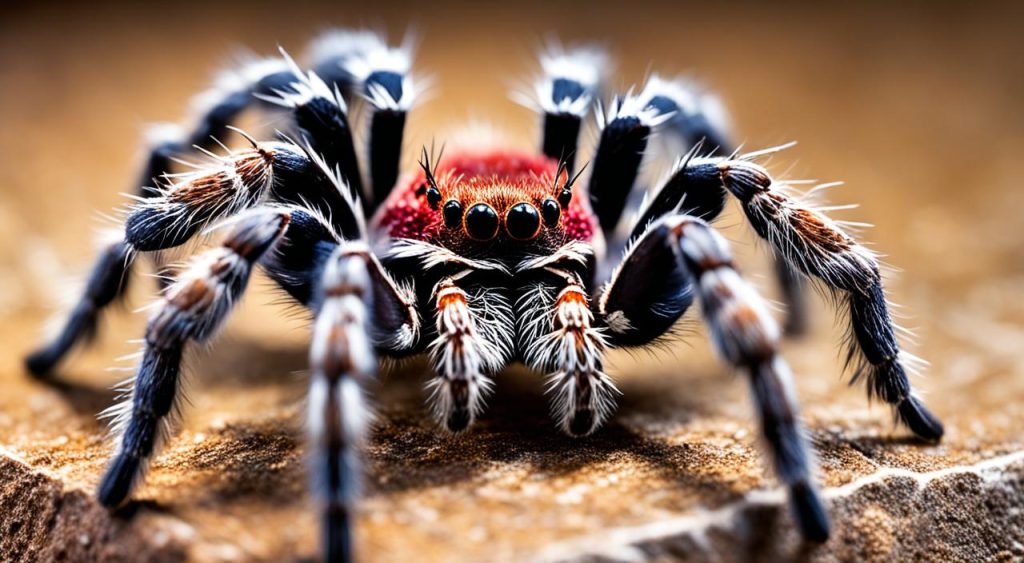
“Tarantulas are fascinating creatures that can make rewarding pets for the right owner. While the Chilean rose has many appealing traits, it’s essential to carefully consider the pros and cons before bringing one into your home.”
Acquiring a Chilean Rose Tarantula
If you’re thinking about getting a Chilean rose tarantula as a pet, there are important things to consider. It’s best to buy from a trusted breeder or rescue group. They can give you detailed info on the spider’s past and health, making it easier for it to settle into your home.
Where to Buy and Selection Tips
Looking for a Chilean rose tarantula? You can find them for $20 to $60. Females are pricier because they live up to 20 years, while males only 4-5 years.
When picking a rose hair tarantula, choose one that looks alert, eats well, and is healthy. Stay away from spiders that seem tired or mean, as they might be sick. It’s also smart not to keep many spiders together to avoid accidental breeding.
For grammostola rosea breeders, check out online marketplaces and reptile/arachnid shows. These sellers offer great advice on caring for Chilean rose tarantulas, making your experience rewarding.
“Purchasing from a breeder or rescue allows you to gain valuable insights into the tarantula’s background, temperament, and specific needs, which is crucial for providing the best possible care.”
Reproduction and Lifecycle
The Chilean rose tarantula, known as Grammostola rosea, has a unique way of reproducing. When they grow up, males develop a special “finger” on their front legs. They use this to lock the female’s fangs during mating.
For mating to work, the female must have molted recently. This is because she’ll lose the sperm during her next molt. After mating, she lays 50 to 200 grammostola rosea eggs in a safe web. She guards these eggs until they hatch.
Growth and Molting Stages
Chilean rose tarantulas, like other rose hair tarantula molting spiders, need to molt several times to grow. Baby tarantulas, or spiderlings, molt five or six times in their first year. Each molt lets them shed their old skin and grow a new, bigger one.
- Eggs: 6–9 weeks
- Spiderlings: 6 weeks–9 years
- Adults: 3–12 years
Chilean rose tarantulas can live over a decade in captivity. Keeping them in a warm place, between 70-80°F, is key. This helps them live a long and healthy life.
“The specimen’s life expectancy exceeded the average range expected for an adult male tarantula, highlighting the unique longevity of this individual.”
Habitat and Range in the Wild
The Chilean rose tarantula, known as Grammostola rosea, lives in the deserts and scrublands of Chile, Bolivia, and Argentina. These spiders love different environments, from dry lands to wet forests by the coast.
Chilean rose tarantulas make their homes in burrows they dig or take over from others. They line these burrows with silk to make them safe and cozy. These spiders live between 0 and 1,500 meters above sea level, with their burrows close together in crowded areas.
These tarantulas eat insects, invertebrates, and sometimes small animals. They help keep the bug population down, acting as important predators.
The Chilean rose tarantula mates twice a year, in September to March and May to July. After mating, the female lays 50 to 200 eggs in a web. These eggs hatch in about two to three weeks.
Interesting Facts about Chilean Rose Tarantulas
The Chilean rose tarantula, also known as the Grammostola rosea, is a fascinating spider species. They get their name from the pink color of their body hairs. This gives them a unique and eye-catching look. These tarantulas are one of the most popular pets in the United States.
Many think that female Chilean rose tarantulas kill the male after mating. But, this is not often true. In fact, most males can live an extra one to two years after mating. Also, no tarantula species can kill a person. Their venom is as mild as a bee sting for most people.
These tarantulas come from the desert regions of northern Chile, Bolivia, and Argentina. They are known for being gentle, making them a great choice for spider lovers. With the right care, a Chilean rose tarantula can be a fascinating and rewarding pet for many years.
FAQ
What are the common names and scientific classification of the Chilean rose tarantula?
The Chilean rose tarantula is also known as the rose hair or Chilean fire tarantula. Its scientific name is Grammostola rosea.
What is the physical appearance and size of the Chilean rose tarantula?
These tarantulas have bodies that can be black or brown, with vibrant red and orange hairs. Adults have a leg span of 4.5 to 5.5 inches. Females are a bit larger than males. Their bodies are about 3 inches long.
What is the temperament and behavior of Chilean rose tarantulas?
They are known for being calm and not biting easily. While they can be handled gently, they are not truly tame. They have venom and urticating hairs for defense.
What are the housing requirements and environmental conditions for a Chilean rose tarantula?
They need a 5- to 10-gallon tank with a secure lid and good air flow. The tank should have a hiding spot. Use 2-3 inches of a suitable substrate like peat moss or coconut husk. They don’t need high humidity, 65% is enough.
How do Chilean rose tarantulas feed and hydrate?
Feed them live insects like crickets that are well-fed beforehand. Make sure they have a shallow dish of water that is changed daily.
What are the molting process and common health concerns for Chilean rose tarantulas?
They shed their skin during molting, which can be stressful. Don’t feed or handle them during this time. They are usually healthy if given the right environment.
What are the exercise and grooming needs of Chilean rose tarantulas?
They don’t need much exercise, just a big enough enclosure to move in. They clean themselves during molting and don’t need help from their owners.
What is the cost of owning a Chilean rose tarantula?
Ongoing costs include feeding them live insects, which costs about $5-$10 a month. You’ll also spend $10-$20 on substrate and tank items. Don’t forget to budget for vet care and emergencies.
What are the pros and cons of keeping Chilean rose tarantulas as pets?
They are easy to care for and not usually aggressive. However, they have venom and urticating hairs for defense. They are not as active or interactive as some pets.
Where can I acquire a Chilean rose tarantula, and what should I look for when selecting one?
You can find them in pet stores or from reputable breeders or rescue groups. Look for a healthy, alert spider with a good appetite. Avoid buying multiple spiders to prevent accidental breeding.
How do Chilean rose tarantulas reproduce and go through their lifecycle?
Males develop a special “finger” for mating after reaching maturity. Females must molt recently to reproduce. They lay 50 to 200 eggs in a web, guarding them. They molt several times to grow, shedding their skin for a new, larger one.
Where are Chilean rose tarantulas found in the wild?
They live only in Chile, South America. Their homes range from Mediterranean climates to coastal rainforests. In the wild, they dig burrows or take over those of rodents.
What are some interesting facts about Chilean rose tarantulas?
They get their name from their pink hairs and are the most common pet tarantula in the U.S. It’s a myth that female Chilean rose tarantulas always kill the male after mating. Most males live another year or two after mating.
